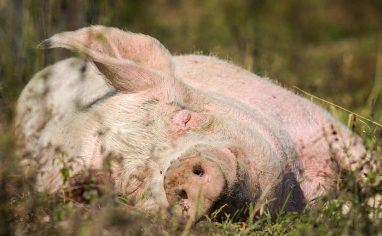

Veterinary Review Initiative
This resource was reviewed for accuracy and clarity by a qualified Doctor of Veterinary Medicine with farmed animal sanctuaryAn animal sanctuary that primarily cares for rescued animals that were farmed by humans. experience as of April 2025.
Check out more information on our Veterinary Review Initiative here!
If you’ve spent much time looking through our offerings, you likely know the important role routine health checks play in keeping residents healthy and catching signs of concern early. Performing health checks regularly is imperative, but this should not be the only tool you use to monitor your residents’ health and well-being. The importance of thoughtful daily observation cannot be overstated. While some issues may be difficult to detect without a hands-on health checkThe Open Sanctuary Project uses the term "health check" to describe health evaluations performed by caregivers who are not licensed veterinarians. While regular health checks are an important part of animal care, they are not meant to be a replacement for a physical exam performed by a licensed veterinarian., there are other potential signs of concern that could be missed during a health check, particularly those that manifest as slight changes in behavior or activity. By incorporating both daily observation and routine health checks into your care protocols, you are more likely to catch issues that develop in the period between health checks, as well as issues that are unlikely to be detected without a hands-on evaluation.
When it comes to daily observation, the keyword is “thoughtful.” Daily observation of residents must be more than just looking at them. Anyone caring for an animal, regardless of their species or breed, should be trained to observe the individuals in their care for behaviors and physical signs that are abnormal for the species, keeping in mind issues that are common in a particular species or breed and their warning signs. Of equal importance is getting to know the individuals being cared for and watching for things that are out of the ordinary for that particular individual. To read more about refining your observation skills, check out our resource here.
Familiarize Yourself With “Normal”
To identify signs of concern, it’s helpful to first consider how a healthy alpaca typically looks and acts. There are some general characteristics that most healthy alpacas will present, but keep in mind that alpacas are unique individuals, so it’s also important to learn what is “normal” for each individual in your care.
With that in mind, in general, a healthy alpaca should:
- Be bright and alert, though they do relax during the day
- Have clear, bright eyes
- Regurgitate and chew cudFood matter that returns from the first stomach compartment back to the mouth for further chewing
- Rise from lying down with ease
- Walk with an even gaitA specific way of moving and the rhythmic patterns of hooves and legs. Gaits are natural (walking, trotting, galloping) or acquired meaning humans have had a hand in changing their gaits for "sport". and bear weight evenly on all four legs
- Urinate and defecate with ease and without signs of pain
- Produce well-formed fecal pellets using a communal dung pile (you can read more about evaluating camelid feces here)
Potential Signs Of Concern
Now that we’ve got an idea of what is “normal,” let’s look at potential signs of concern. Because every resident is an individual, it’s important to get to know the unique individuals in your care so you can recognize when they are not acting like themselves. Caregivers who really spend time getting to know their residents in terms of their personality, typical behaviors, physical characteristics, and routines can sometimes catch when something is wrong before there are clear signs of illness or distress. Sometimes it’s something as subtle as an individual not responding to your presence in the way you would expect. Any time you notice a change in an individual’s typical behavior or routine, it’s a good idea to perform a health check and keep a close eye on them.
While not an exhaustive list, during your daily observation of your residents, be on the lookout for the following:
General signs of pain/discomfort, such as…
- Groaning or grunting
- Tooth grinding
- Lying down and then immediately standing back up over and over, as if they cannot get comfortable
- Lying down in an unusual position or frequently changing positions while lying down
- Sensitivity or reactivity to being touched
Changes in their posture, gait, mobility, or activity level, such as…
- Spending more time than usual lying down
- Difficulty, inability, or unwillingness to rise
- Lying down with their neck extended on the ground in front of them or bent so their head is resting on their back
- Limping, stiffness, dragging, weakness, taking shorter steps than usual, or trying to keep weight off a particular limb
- Hyperextended fetlocks (dropped pasterns)
- Muscle tremors
- Weakness, a wobbly gait, incoordination, or circling
- A hunched posture
Changes to their physical appearance, such as…
- Weight loss or a loss of body condition
- Anything beyond a small bit of clear nasal discharge (cloudy or bloody nasal discharge is cause for concern)
- Hair loss
- Excessive dandruff
- Red or crusty skin
- Squinting, ocular discharge (may be noticed as wetness or discoloration of the hair under the eye), or changes to the appearance of the eye (including cloudiness)
- A droopy ear or unusual ear positioning
- Asymmetry of the face or facial paralysis
- Abdominal distension
- Swollen joints
- Swelling of the jaw or swelling/fluid build-up under the jaw (“bottle jaw”)
- Pale mucous membranes
- Rectal prolapsethe falling down or slipping of a body part from its usual position or relations
- Head tilt
- Changes to the color or texture of the hair
Changes in behavior, such as…
- Separating themselves from their herd mates
- A docile individual becoming aggressive or a more assertive individual becoming submissive
- Rolling more than usual
- Kicking at their abdomen
- Scratching or rubbing excessively
- Head pressing
- Head shaking or scratching at the ear
Changes to their eating and drinking, such as…
- Disinterest in eating or eating less than usual
- Not drinking water or drinking water excessively
- Excessive frothing at the mouth when eating
- Abnormal chewing motions
Other things to watch for include…
- Open-mouth breathing, significant nostril flaring, labored breathing, coughing, or audible breathing
- An elevated or slow respiratory rate (normal is between 10-30 breaths per minute)
- Abnormal rectal temperature (normal range is 99.5-101.5 degrees Fahrenheit / 37.5-38.6 degrees Celsius, though when the weather is hot, it could reach 104 degrees Fahrenheit / 40 degrees Celsius)
- Changes in posture when defecating
- Changes in the frequency of defecation / spending more time at the communal dung pile than usual
- Difficulty or straining during urination or defecation
- Cloudy urine or unusually colored urine (reddish, whitish, etc.)
- Loose or soft stool/diarrhea
- Black, tarry stool
- Excessive salivation
If you see any of the signs above or anything else out of the ordinary, be sure to investigate further and consult with your veterinarian as needed. Depending on the severity and whether or not there are multiple signs of concern, the individual may need to be seen by a veterinarian immediately. In some cases, conducting a health check, either in full or in part, can help you to gather more information about the individual to share with your veterinarian so they can help determine the best course of action.
Now that you have an idea of what to look for, be sure to build thoughtful daily observation into your caregiving routine if you haven’t already! The more you observe your residents, the better you’ll become at differentiating between “normal” and potentially concerning. Whenever you’re in doubt, err on the side of caution and contact your veterinarian for guidance.
SOURCES:
Alpacas – Health | New South Wales Department Of Education
Dealing with Common Maladies of Camelids | Tessa Marshall, BVSc, MS, DABVP
The Healthy Alpaca | NADIS (Non-Compassionate Source)
Medicine And Surgery Of Camelids, 4th Edition (Non-Compassionate Source)
BSAVA Manual Of Farm PetsAnimals who spend regular time with humans in their home and life for companionship or human pleasure. Typically a small subset of animal species are considered to be pets by the general public. (Non-Compassionate Source)
Alpaca General Medicine Lecture | Peaceful Hearts Alpacas (Non-Compassionate Source)
Diseases Of Llamas And Alpacas | Merck Veterinary Manual (Non-Compassionate Source)
Non-Compassionate Source?
If a source includes the (Non-Compassionate Source) tag, it means that we do not endorse that particular source’s views about animals, even if some of their insights are valuable from a care perspective. See a more detailed explanation here.






